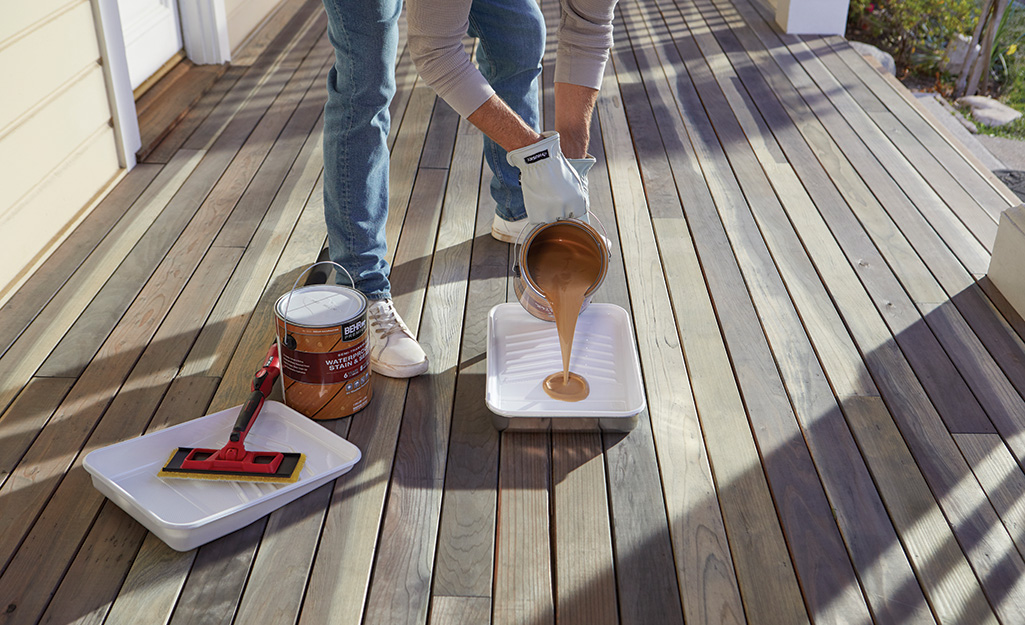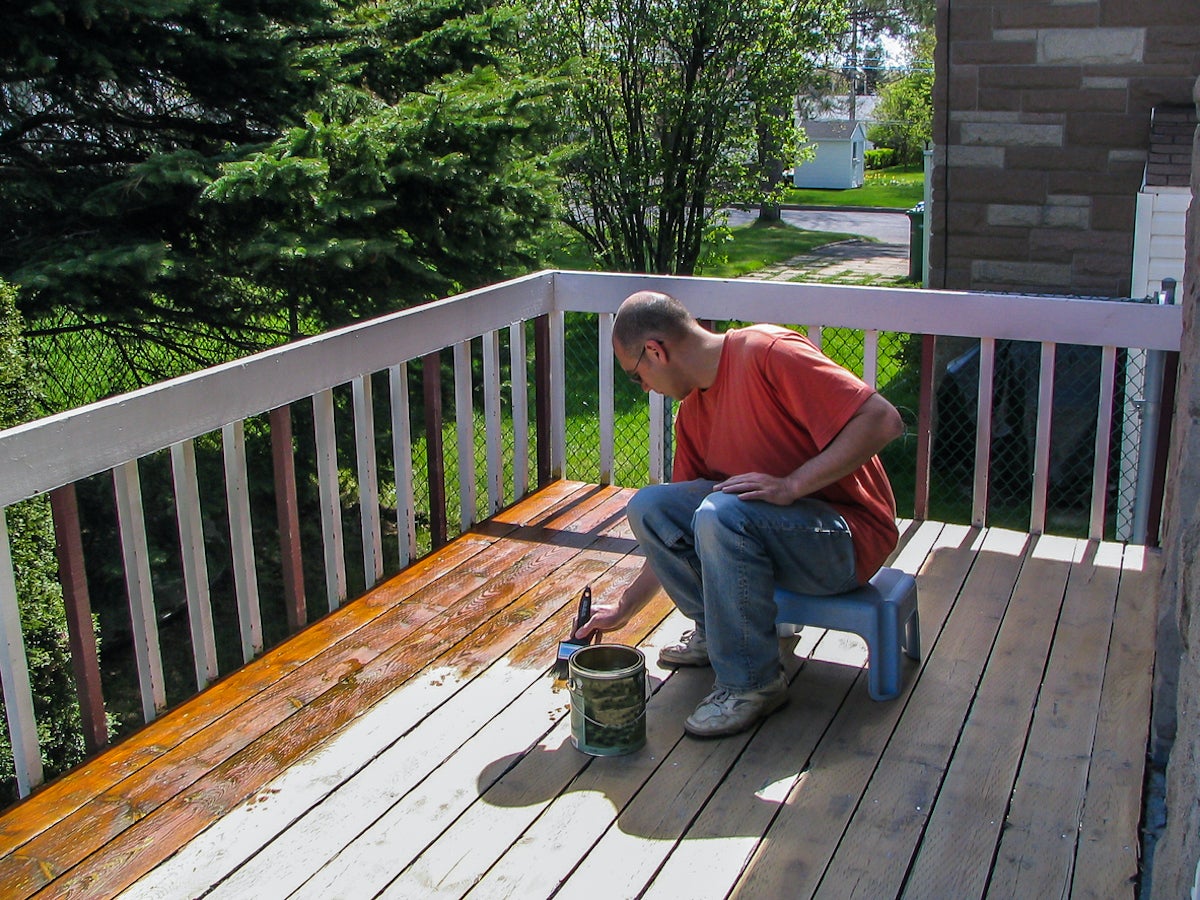A Comprehensive Guide to Different Types of Deck Discoloration Techniques for Ultimate Security and Visual Appeals
In the world of deck maintenance, the art of staining stands as a pivotal action towards both preserving the honesty of your outside space and boosting its aesthetic appeal. As we browse with the intricate globe of deck staining strategies, one begins to appreciate the nuanced strategies that can make all the distinction between a sub-par surface and a flawless one.
Comprehending Different Sorts Of Discolorations
Different kinds of stains are commonly made use of in the process of deck staining to achieve different aesthetic and protective impacts. Clear spots are perfect for showcasing the all-natural grain of the wood while providing marginal protection versus UV rays and moisture. On the various other hand, semi-transparent discolorations offer an equilibrium between color improvement and security, permitting some wood grain to show via. For a more opaque coating that provides maximum defense versus the elements, solid discolorations are the preferred option. These discolorations come in a large range of colors and properly hide the wood grain.
Toners include a hint of color to the wood while offering very little defense, making them suitable for newer decks with less wear. Comprehending the features and advantages of each kind of tarnish is important for accomplishing the desired look and longevity for your deck.
Picking the Right Spot Color
When considering the appearances of your deck discoloration job, the selection of stain shade plays an essential duty in boosting the protective high qualities of the selected discolor type (Right Deck Stain). The color you pick can significantly affect the overall look of your deck, along with its capacity to stand up to the elements with time
When choosing a stain shade, it's necessary to consider the existing color design of your home's outside. Balancing the deck stain with the total aesthetic of your home can develop a cohesive and aesthetically appealing outside room. Furthermore, the shade of your deck stain can affect the temperature of the deck surface area; darker colors often tend to absorb more warmth, while lighter colors reflect sunshine and stay cooler.
In addition, the sort of timber you are tarnishing will likewise affect just how the stain color appears. Various timber species can connect with the discolor in different means, potentially changing the last shade. It's advisable to check the stain on a small, unnoticeable location of the deck to make certain the color ends up as preferred before proceeding with the whole task.
Preparing Your Deck for Discoloration
To ensure a durable and successful deck staining project, complete prep work of the deck surface area is essential. Begin by cleaning the deck extensively to eliminate dirt, grime, mildew, and any type of old complete or discolor. Utilize a deck cleaner or a mixture of water and detergent along with a tight brush or stress washing machine to scrub the surface area tidy. After cleansing, permit the deck to completely dry entirely prior to proceeding to the following action.
Check the deck for any type of harmed or rotten boards that need to be replaced. Hammer down any protruding nails and sand any harsh locations to make certain a smooth surface area for discoloration. Look for any kind of loose railings or steps that might require tightening up or fixing.
When the deck is clean, dry, and in great fixing, consider using a timber brightener to bring back the deck's natural shade and open the wood pores for far better tarnish infiltration. Shield any close-by plants, furniture, or surfaces with plastic bed linen prior to continuing with the staining procedure. Correct preparation is crucial to achieving a professional-looking surface and taking full advantage of the long life of your deck stain.
Applying Discoloration With Various Methods
For a remarkable and professional coating, the method of applying discolor plays an essential function in boosting the appearance and toughness of your deck. There are a number of methods you can use to make certain an effective application of stain.
It is perfect for elaborate areas and reaching in between deck boards. Back-brushing after rolling is advised to also out the tarnish and function it into the timber for far better infiltration.
Splashing is another popular strategy, using speed and convenience of application, specifically for big deck locations. Whichever method you choose, ensuring correct prep work and complying with producer This Site guidelines will certainly help accomplish a lasting and stunning discolor finish on your deck.

Maintaining and Re-staining Your Deck
When it comes to re-staining your deck, the frequency depends on numerous elements such as the kind of stain made use of, the climate in your location, and how much wear and tear your deck experiences. Normally, it is recommended to re-stain your deck every 2-4 years to preserve its protection and looks.
Before re-staining, make sure the deck is clean, dry, and cost-free of any type of previous tarnish residue. Sanding might be necessary to ravel harsh areas or eliminate old tarnish that is flaking. Choose a high-grade discolor that matches your deck's material and supplies the wanted level of security. Use the stain uniformly making use of the appropriate strategy discussed earlier in this overview to ensure a attractive and lasting surface - Stain Deck. By staying aggressive with maintenance and re-staining, you can delight in a well-protected and aesthetically appealing deck for years to find.
Final Thought
In verdict, understanding the different kinds of deck stains, choosing the best color, helpful resources properly preparing the deck, applying discolor with different techniques, and maintaining and re-staining the deck are crucial actions for ultimate protection and visual appeals. By complying with these actions, you can make certain that your deck remains in top condition for many years ahead.
Additionally, the color of your deck tarnish can affect the temperature level of the deck surface area; darker shades often tend to soak up even more warmth, while lighter shades mirror sunlight and stay cooler.
It's advisable to examine the tarnish on a tiny, unnoticeable area of the deck to guarantee the color transforms out as wanted before proceeding with the entire task.

Comments on “Water-Based Stains for a Beautiful Deck: Eco-Friendly and Effective”